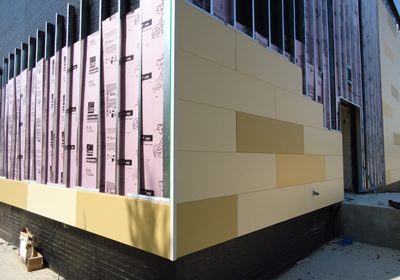Demand in the U.S. for fiber cement products is forecast to rise 8.5 percent annually through 2017 to 2.9 billion square feet—valued at $2.2 billion—according to a new study from The Freedonia Group, Inc., a Cleveland-based industry market research firm. “Advances will be driven by a rebound in residential building construction spending, particularly in the new housing segment,” states Matt Zielenski, an analyst with The Freedonia Group. Growth will be further spurred by increasing use of fiber cement products because of their favorable aesthetic and performance properties. These and other trends are presented in Fiber Cement.
The new residential market is expected to see the most rapid growth in fiber cement demand through 2017, advancing over 16 percent annually as housing starts rise from their low 2012 base. Home builders will be more likely to specify siding and exterior trim made from fiber cement because it can be made to look like such costly materials as brick and stone. Other builders may select fiber cement siding because it is perceived as more attractive than vinyl. The residential improvement and repair market accounted for the largest share of fiber cement demand in 2012. Consumer interest in bathroom renovation projects supported demand for fiber cement backerboard installed beneath decorative tile flooring and bathtub and shower surrounds as it is less costly than fiberglass-reinforced cement, while providing comparable moisture resistance.
Nonresidential demand for fiber cement is forecast to rise steadily through 2017, spurred by rebounding nonresidential building construction. Fiber cement siding will be specified in structures where both aesthetics and durability are important, such as coastal resorts or high-end hotels. For instance, Norcross, Ga.-based Nichiha U.S.A. Inc., recently provided fiber cement panels for the Willie De Leon Civic Center renovation project in Uvalde, Texas. (See page 72).
Siding accounted for the largest share of fiber cement products demand in 2012 with over twothirds of the total. Fiber cement siding has seen its share of U.S. siding demand rise over the past decade as builders and homeowners became more familiar with the performance and aesthetic advantages of the material. Siding made from fiber cement has largely supplanted wood siding because
fiber cement is nearly impervious to degradation and requires less maintenance than wood.
Through 2017, the study notes, fiber cement siding demand will advance rapidly, fueled by rebounding housing starts. In the South, more homes will feature fiber cement siding because it is less costly than brick. Fiber cement is also seen as a more attractive alternative to vinyl siding, which will promote the adoption of the material in the Midwest and Northeast. Fiber Cement (published January 2014, 253 pages) is available for $5,100 from The Freedonia Group, Inc., www.freedoniagroup.com.
